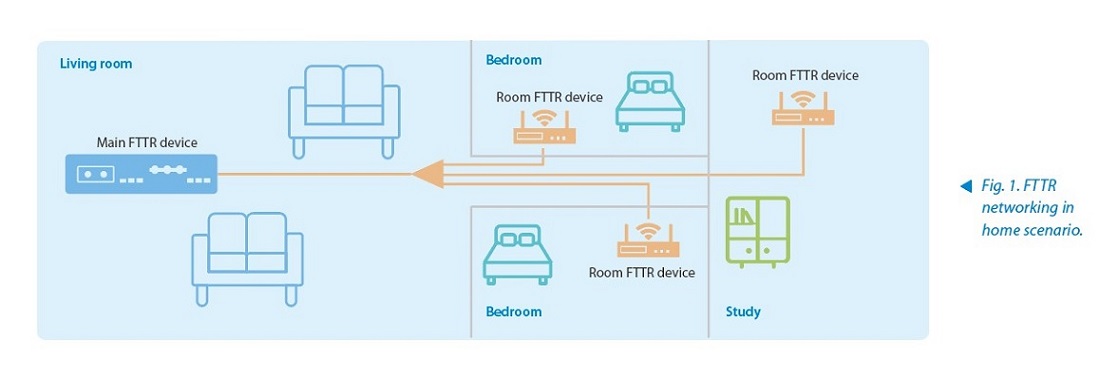Laser Sensing Technology and Its Applications
With the rapid advancement of artificial intelligence (AI) technology, the intelligent transformation of various industries is accelerating. Among the most extensive application scenarios in daily life, the development of smart homes has garnered significant attention. Smart homes encompass a wide range of intelligent devices, including smart appliances and security systems, and involve multiple technical fields such as Internet, automation, communication, and sensing technology.
Sensing technology is the core of smart homes. Existing smart home solutions typically require the deployment of multiple independent sensing devices, such as thermometers and cameras, which often lead to high interface costs, occupy valuable space, and create detection blind spots. However, laser sensing technology offers a feasible solution to these challenges. By integrating with the existing fiber infrastructure deployed in fiber access networks, laser sensing can enhance the capabilities of smart homes.
Future Trend: Integrating Laser Sensing with Fiber Optic Communication
The working principle of laser sensing technology involves laser detection signals reaching the test area via an optical transmission medium. When the measured parameters such as pressure, strain, acceleration, and sound waves interact with these laser signals, their optical properties—intensity, wavelength, frequency, phase, and polarization state—change, resulting in modulated optical signals. These signals are then transmitted to an optical signal detector through the optical medium, where they undergo optical-electrical signal conversion. After demodulation, the measured parameters can be obtained.
Laser sensing technology is categorized into fiber optic sensing and light detection and ranging (LiDAR) based on the optical transmission medium used. LiDAR uses free space as the transmission medium, while fiber optic sensing employs optical fibers as sensing materials to detect environmental changes around them. Existing mature fiber optic sensing systems include distributed acoustic sensing, distributed temperature sensing, and distributed strain sensing systems, all capable of monitoring vibration, temperature, and strain changes in the vicinity of the fibers. These systems can cover sensing ranges of tens of kilometers with meter-level resolutions. Most existing products are specialized systems that require the deployment of dedicated fiber optic lines.
The integration of fiber optic sensing and fiber optic communication represents a promising research direction. With large-scale fiber infrastructure already in place, fiber optic communication can leverage sensing technologies to unlock additional value. This integration enables the delivery of high-speed data services alongside sensing capabilities, ultimately offering customized solutions that provide greater value to users.
Research on the integration of fiber optic sensing and fiber optic communication is still in its early stages. Current fiber optic sensing technology can achieve a spatial resolution of less than one meter, meeting the internal sensing precision requirements for home applications. Exploring how to combine fiber optic sensing technology with the fiber to the room (FTTR) networks being deployed is an important development direction. ITU has begun preliminary standardization efforts, sparking extensive discussions. It is anticipated that related standards will be preliminarily completed by 2026.
LiDAR, an acronym for light detection and ranging, utilizes laser sensing technology to analyze modulated optical signals. It obtains the distance between the laser transmitter and the target object to be measured, along with the intensity, frequency, and phase of the reflected light signal, to generate accurate three-dimensional structural information. This capability allows for detailed reconstruction of the target’s movement and shape changes, enabling track detection and action recognition.
Typical Scenarios Integrating Laser Sensing and FTTR
In a smart home, FTTR technology provides high-speed data connections to individual rooms. Fig. 1 illustrates a typical FTTR networking configuration. Distributed fiber optic sensing technology leverages existing FTTR fiber resources to monitor various parameters in the room in real-time. Integrating high-speed data connections with real-time sensing services effectively meets the diverse needs of smart homes.
Fire safety is a crucial aspect of smart home security. A distributed fiber temperature sensing system provides real-time temperature monitoring within the home. By analyzing this temperature data, the system can detect abnormal environmental changes and offer early fire warnings to implement smart security. Additionally, FTTR’s high-speed data connections enable remote alerts and fast alarms, ensuring the safety of both users and their property.
Intrusion detection is essential for smart homes. A distributed fiber optic vibration sensing system can identify potential intrusions by monitoring vibrations, triggering and activating other smart home devices. Additionally, data from these devices, such as video footage, can be transmitted remotely to the user via FTTR technology.
The distributed fiber optic vibration sensing system is well-suited for smart home applications. FTTR-based fiber optic sensing can analyze vibration data within the home to determine occupancy, enabling the use of smart switches. By monitoring vibrations across multiple rooms, the system can estimate occupants’ locations, facilitating automated adjustments of home appliances. Moreover, temperature data from the sensing system can guide the autonomous adjustment of air conditioners and other electrical devices.
LiDAR technology has been widely used in autonomous driving and other application scenarios. As the industry chain matures, it is expected to find uses in smart homes. By integrating LiDAR and fiber optic sensing into the ONU device of FTTR systems, we can achieve coarse-granularity sensing for application scenarios like household security monitoring and tracking elderly individuals with Parkinson’s disease. For fine-granularity sensing, potential application scenarios include motion analysis and respiratory monitoring. These advancements in sensing technology are poised to create new market opportunities.
FTTR technology enables gigabit all-optical access, delivering high-speed data connectivity. By leveraging fiber optic devices and high-speed data pipelines, laser sensing technology provides real-time perception services on a room-by-room basis. The deep integration of FTTR and laser sensing fully utilizes the capabilities of high-speed optical access networks, driving the advancement of intelligent technologies.
